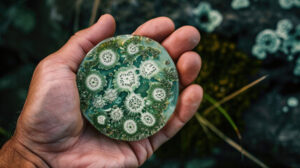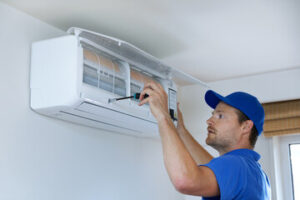Whether you’re doing due diligence to make sure a potential home is mold-free or simply concerned about your indoor health, a professional Mold Inspection Staten Island is well worth the money. A basic inspection costs $50 – $800.

A certified inspector will start with a visual inspection which can include air and surface testing. They’ll swab and culture samples for analysis to determine the type of mold and its overall toxicity.
Moisture Sources
Moisture is the main factor that promotes mold growth. Therefore, finding a source of moisture is essential in the diagnosis and remediation of mold problems. There are several different ways to look for signs of mold problems, but the easiest way is to simply visually inspect the area and pay attention to any musty smells or visible mold growth.
The most common places to find mold problems in a home are in the basement, bathroom, and kitchen. These rooms are usually dark, warm, and humid, making them the perfect environment for mold to grow. If the problem is left unattended, mold can damage walls and floors by consuming the material and causing structural damage to the structure.
Another place to look for mold is behind drywall and in crawl spaces and attics. These areas are often overlooked because they are difficult to reach, but can be a source of mold problems if there is a leak in the roof or around the outside of the house. Mold can also grow behind wallpaper, paneling, and carpet pads, as well as inside wall cavities and ductwork.
In some cases, the presence of mold is not apparent even after looking for it in the usual hiding spots, but a musty odor or health problems are a clear indicator that a problem exists. In these cases, a moisture meter is an excellent tool for locating the mold and finding out the cause of the problem.
Once a mold problem is discovered, the first step in any remediation process is to clean up the affected area. This should be done as soon as possible after the discovery, and a thorough cleaning of the surrounding surfaces is required. It is also important to ensure that the area is dry and that any non-washable materials (like mattresses, pillows, or curtains) are replaced with washable ones. Lastly, it is crucial to control the underlying water issues that are allowing mold to grow to prevent the problem from returning and possibly spreading. This can be accomplished through ventilation, air circulation near cold surfaces, dehumidification, and efforts to minimize water production and consumption in the home.
Smells
Mold spores are everywhere in your home, and you are breathing them in every time you go inside. Some of them are harmless, but others produce harmful mycotoxins that can cause a variety of illnesses and symptoms including sneezing, coughing, itchy eyes, and other respiratory issues. Often, a combination of visual inspection and air quality testing is used to determine the presence of harmful mycotoxins in the home.
The first step in a mold inspection is to conduct a visual examination. Mold grows in damp areas and can be easily spotted on surfaces, including walls, floors, and carpets. The inspector will look for discolored surfaces and a foul smell which can be caused by spores. The inspector can also check for other signs of a problem, such as the presence of dust mites and rodent droppings.
In some cases, the inspector will use a thermal imaging camera or infrared scanner to detect damp areas of the property. These cameras are also useful for detecting water intrusion within structural components like plumbing pipes or behind walls.
Depending on the results of the visual inspection, the inspector may take surface samples with various tools such as cotton swabs, tape, or an air cell machine. These samples will be sent to an independent lab unaffiliated with the inspector for analysis. The results can then be compared to outdoor air samples to identify the type and severity of the problem.
If the swab or tape sample indicates a high level of fungal spores, the inspector can perform a culture test to see if the fungi are still alive and can reproduce. This is a more accurate test than simply measuring the number of spores, and it can help pinpoint the source of the problem.
Before an inspection, it’s helpful to clear out any spaces where mold is suspected. A clean space will make the inspection and subsequent remediation easier. You should also cover supply and return vents in the area to prevent releasing additional spores into the air.
Finally, don’t forget to clear out cabinets under sinks and other places where mold can hide. Non-porous materials, such as tile, glass, and hard plastics can be cleaned with household cleaning products or a scrub brush. Porous materials such as wood, drywall, and upholstery are more difficult to clean and may need to be replaced.
Symptoms
Symptoms can include respiratory distress, eye irritation, skin rash, and other health problems. If the symptoms are severe, a mold inspection may be required to diagnose the problem and develop remediation plans. A mold inspection can help determine the type of mold, its severity, and how it’s being spread in a home.
A professional will visually inspect the property, looking for visible signs of mold and water damage. The inspector will also check the air quality in various areas of the house. They will use an air sampler to gather an accurate reading from the dead space (areas behind walls, above ceilings, and under floors) which can then be analyzed at a lab. This is typically the preferred method of sampling for hidden mold and provides a more accurate reading.
If the inspector sees obvious signs of mold growth, they will use a tape lift or swab test to collect samples for testing. A tape lift uses a special tape that sticks to the surface, allowing an inspector to take several samples in one area quickly. The swab test is a cellulose swab with a liquid preservative stored in an ampoule at one end of the swab. Any bacteria that are transferred to the swab are then sent directly to the laboratory for analysis.
In addition to visual inspections, a qualified mold inspector can also use infrared imaging or thermal imaging to detect dampness and leaks in places that aren’t easily accessible during a visual inspection. A thermal imager will show any problem areas as dark gradients on the scanned image.
The most important thing for homeowners to keep in mind is that mold requires moisture to grow. That’s why it’s so important to look for and fix sources of moisture, such as leaky roofs or plumbing issues.
If you have a mold problem, it’s important to immediately fix the cause of the issue so that the mold doesn’t return. And if you have allergies or asthma, it’s even more important to prevent mold from growing in your home, as it can trigger those reactions in people who are sensitive to it.
Remediation
If you suspect you have a mold problem, call a professional to perform a visual inspection and air tests. These tests can help determine whether the mold is simply a result of excess moisture, or whether it might be contributing to other health problems. The swabbing and staining tests can also pinpoint the type of mold, as well as its overall toxin level.
An experienced mold inspector will look for mold in all areas of the home, including areas that are not easily accessible. Hidden mold is often the result of building materials such as dry walls with vinyl wallpaper or wood paneling, which act as vapor barriers and trap moisture in the areas behind them. If this is the case, an inspector might have to disturb the affected area to get a closer look at the problem.
Once the inspection and assessment are complete, the mold remediation process begins. During this stage, containment measures are implemented to prevent the spread of spores to unaffected areas. The mold is then removed using specialized techniques and cleaning agents, and the contaminated material is safely disposed of.
During this step, the mold remediation specialist may also conduct an air quality test to determine whether or not the level of mold spores is within safe limits. If the spore count is too high, the technician can develop a remediation plan that includes removing drywall and carpeting.
The final phase of remediation involves restoring the building materials to their original condition and sanitizing all surfaces. The specialist may use disinfectants to ensure that the mold is completely eradicated from the home. Depending on the type of mold and its level of toxicity, this step could take days or even weeks.
You can greatly reduce the need for mold remediation by taking a few precautions. Avoid excessively damp areas of the house by repairing leaks as soon as they occur, and clean up any spills right away. Also, consider getting a dehumidifier to decrease the level of moisture in the air. Finally, try to increase the amount of natural ventilation in the home.

